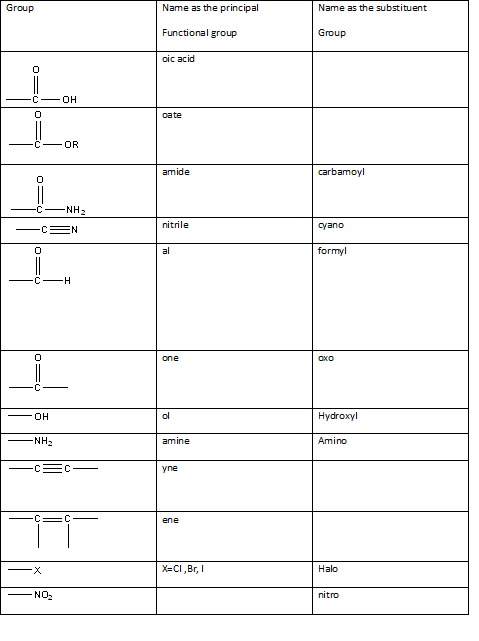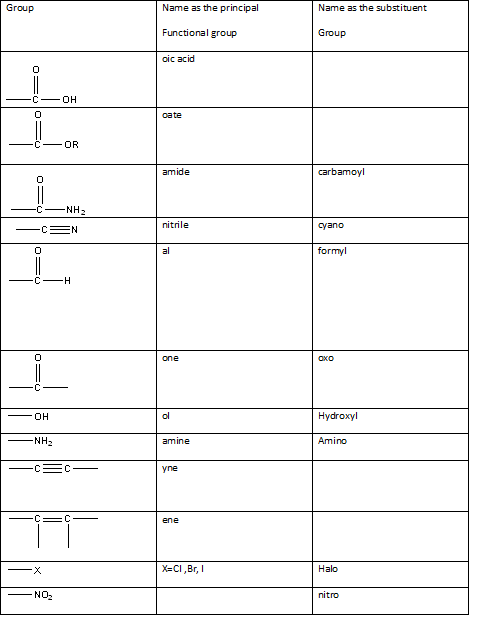
Concept explainers
(a)
Interpretation:
The functional group present in given molecule should be identified and the family of organic compounds to which the compound specifically belongs to should be determined.
Concept Introduction:
The International Union of Pure and Applied Chemistry-IUPAC has developed a method for systematically naming organic compounds.The name given to a compound according to the

Table 1: The series of functional groups arranged in the decreasing order of the priority.
(b)
Interpretation:
The functional group present in given molecule should be identified and the family of organic compounds to which the compound specifically belongs to should be determined.
Concept Introduction:
The International Union of Pure and Applied Chemistry-IUPAC has developed a method for systematically naming organic compounds. The name given to a compound according to the IUPAC nomenclature consists of several parts the critical or the first part is to identify the main functional group present in a molecule in order to name it correctly. It allows the identification of the class of the compound easily possible without any ambiguity. The table indicating the main functional groups present in organic molecules can be summarized in the table below.

Table 1: The series of functional groups arranged in the decreasing order of the priority.
(c)
Interpretation:
The functional group present in given molecule should be identified and the family of organic compounds to which the compound specifically belongs to should be determined.
Concept Introduction:
The International Union of Pure and Applied Chemistry-IUPAC has developed a method for systematically naming organic compounds. The name given to a compound according to the IUPAC nomenclature consists of several parts the critical or the first part is to identify the main functional group present in a molecule in order to name it correctly. It allows the identification of the class of the compound easily possible without any ambiguity. The table indicating the main functional groups present in organic molecules can be summarized in the table below.

Table 1: The series of functional groups arranged in the decreasing order of the priority.
(d)
Interpretation:
The functional group present in given molecule should be identified and the family of organic compounds to which the compound specifically belongs to should be determined.
Concept Introduction:
The International Union of Pure and Applied Chemistry-IUPAC has developed a method for systematically naming organic compounds. The name given to a compound according to the IUPAC nomenclature consists of several parts the critical or the first part is to identify the main functional group present in a molecule in order to name it correctly. It allows the identification of the class of the compound easily possible without any ambiguity. The table indicating the main functional groups present in organic molecules can be summarized in the table below.

Table 1: The series of functional groups arranged in the decreasing order of the priority.
Trending nowThis is a popular solution!

Chapter 20 Solutions
Introductory Chemistry: A Foundation
- Functionalized Hydrocarbons Identify each compound according to its functional group (e.g.,amine,ester,etc.):arrow_forwardWhat are functional groups? Why is it logical and useful to classify organic compounds according to their functional groups?arrow_forwardMatch the following organic compounds with their functional group.arrow_forward
- explained why there are so many organic compounds. Which is the main element in all organic compounds and why?arrow_forwardThe following molecules only have a single functional group. Identify to which class of organic compounds each molecule belongs based on its functional group.arrow_forwardExplain properly. Draw two different diagrams of the benzene molecule. Explain what each diagram shows, and state which diagram is thought to be more correct.arrow_forward
- what are the different ways that organic chemistry is important to our society?arrow_forwarda) what two types of bonds are present in alkynes but not alkanes? b) draw the structure of an alkyne that would not have one of the two bonds. Explain.arrow_forwardWhich functional group or groups are not present in the compound shown in the Figure. a) Alcohol b) Amide c) Ether d) Alkyne e) All these functional groups are present in the compound.arrow_forward
 Introductory Chemistry: A FoundationChemistryISBN:9781337399425Author:Steven S. Zumdahl, Donald J. DeCostePublisher:Cengage Learning
Introductory Chemistry: A FoundationChemistryISBN:9781337399425Author:Steven S. Zumdahl, Donald J. DeCostePublisher:Cengage Learning
- Chemistry: Matter and ChangeChemistryISBN:9780078746376Author:Dinah Zike, Laurel Dingrando, Nicholas Hainen, Cheryl WistromPublisher:Glencoe/McGraw-Hill School Pub Co
 Chemistry for Today: General, Organic, and Bioche...ChemistryISBN:9781305960060Author:Spencer L. Seager, Michael R. Slabaugh, Maren S. HansenPublisher:Cengage Learning
Chemistry for Today: General, Organic, and Bioche...ChemistryISBN:9781305960060Author:Spencer L. Seager, Michael R. Slabaugh, Maren S. HansenPublisher:Cengage Learning




